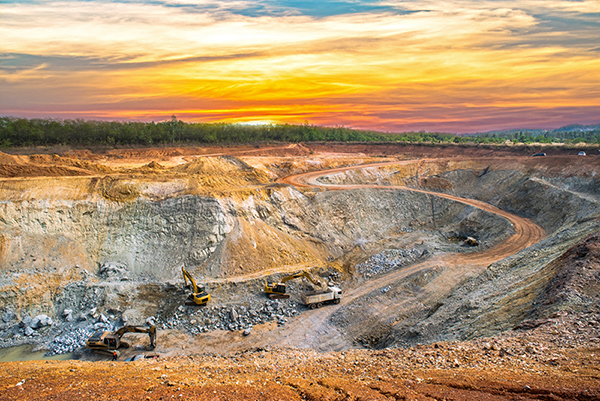From the California gold rush to the deep-sea mining permits underway today, mining has pushed the boundaries of human exploration. Beyond its economic importance, mining has played a vital role in shaping the identity of many towns and regions, including the 91 Texas counties with recorded mine claims.
Texas is rich in various minerals and metals, such as coal, copper, limestone, gypsum, and gravel. Most of the mining in the state today involves surface mining such as quarrying, strip mining, and open-pit mining. However, underground mining and Frasch and in-situ mining (methods of using liquids to extract minerals) are used in some parts of the state primarily for salt, sulfur, and uranium. Each of these materials and the techniques to extract them can create serious hazards for employees. These tips can help foster an industry of safe mines and healthy workers.

1 Wear respiratory protection.
Miners may be exposed to dust, debris, and gas that can pose health risks when inhaled. The proper respiratory protection --- such as dust masks and powered air-purifying respirators -- can prevent:
- black lung disease (pneumoconiosis) from coal dust;
- chronic obstructive pulmonary disease (COPD), lung cancer, and silicosis from silica dust;
- lung cancer and mesothelioma from asbestos;
- lung cancer from radon gas; and
- respiratory problems from diesel fumes.
2 Enforce a fall prevention and protection program.
Fall-from-height accidents at mines result in over 100 fatal and serious injuries each year. Help prevent these incidents by providing walkways and platforms with handrails and requiring employees working at heights to use fall protection, such as body harnesses with retractable lanyards. Provide employees with secure anchor points, training that prohibits work at unprotected locations, and mobile or stationary platforms or scaffolding at locations where there is a risk of falling.
3 Watch for overhead power lines.
Three miners were electrocuted within ten days this year when overhead power lines came in contact with their trucks. Make sure no part of the equipment gets closer than 20 feet to power lines. Never allow dump trucks to move forward or backward with a raised bed near power lines. If equipment contacts a power line, stay in the vehicle. Have someone call emergency services, warn others to stay away, and wait until the power can be de-energized. If the vehicle is on fire, jump from the truck, landing with both feet together. Do not touch the truck and the ground at the same time. Then, shuffle both feet for at least 30 feet while moving away from the truck.
4 Maintain the worksite to prevent vehicle rollover accidents.
Miners frequently die when vehicles tip, flip, or roll over. Some common causes of rollovers are vehicles:
- operating on uneven surfaces or a slope when dumping;
- driving onto loose ground, causing the wheels to settle unevenly; and
- poor maintenance that results in stability issues caused by uneven tire pressure, failing suspension systems, faulty lifting cylinders, or jammed tailgates.
These hazards can be prevented by ensuring roadways are level and regularly compacted, dumping on slopes is avoided, and vehicles are regularly maintained. Other best practices include operating at safe speeds and requiring the use of a four-point seatbelt system to keep the worker inside the cab during rollovers.
5 Use lockout-tagout procedures when maintaining conveyor belts.
Since January 2017, four miners have died while working around conveyor belts in mines. Using a safety procedure known as lockout-tagout (LOTO) can prevent deaths like these. LOTO ensures equipment is properly shut off and unable to start by accident during maintenance or repair work. These LOTO steps can save lives.
6 Know and follow an approved roof control plan to prevent collapses and cave-ins.
In 2016, the Mine Safety and Health Administration (MSHA) updated its Best Practices to prevent and predict roof collapses. Yet, ground fall collapses remain a serious mining hazard. From January 2017 to August 2021, the U.S. coal mining industry experienced more than 1,967 roof and rib (pillar) accidents resulting in nine deaths and 570 lost-time accidents. To reduce or eliminate these accidents, remain alert to changing conditions that may affect the roof or rib conditions and install added supports as outlined in MSHA’s Best Practices. Never travel under an unsupported roof.
7 Communicate hazards as they change in the workplace.
Unlike many workplaces, mines constantly change. Soil and rock can shift, dangerous atmospheres and chemicals may be present, and powered equipment is on the move. Changes must be communicated quickly to inform workers of the dangers. Having a verbal, written, and nonverbal communication system in place, along with an industrial printer for updating signs and labels, can increase mining health and safety.
For more tips on mining safety and health, visit MSHA.gov, the Railroad Commission of Texas-Mining and Exploration, or the Texas Bureau of Economic Geology. Also check out DWC’s free streaming mining safety videos.
